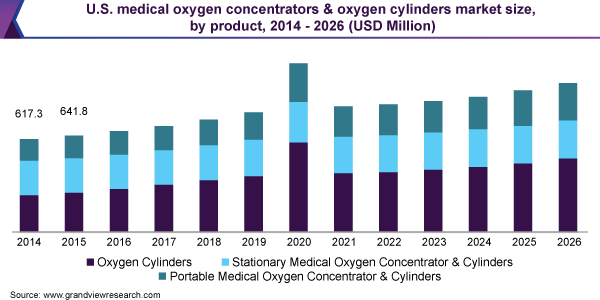Medical Oxygen Concentrators & Oxygen Cylinders Industry Overview
The global medical oxygen concentrators and oxygen cylinders market size was valued at USD 2.9 billion in 2019 and is expected to grow at a compound annual growth rate (CAGR) of 4.2% from 2020 to 2026.
Growing incidence of Chronic Obstructive Pulmonary Diseases (COPDs) and increasing technological advancements for the miniaturization of the oxygen concentrators are some of the key factors expected to drive the market over the forecast period.
In addition, manufacturers are introducing new technologies in concentrators that aim to improve the quality of care. For instance, in February 2018, GCE healthcare launched a remote monitoring platform, called Clarity for oxygen concentrators. The technology monitors the patients and regularly sends the data related to oxygen purity, device location, and battery life to provider and patient’s family members. Such technological advancements in portable concentrators attract more customers and hence create demand for oxygen concentrators.
Gather more insights about the market drivers, restrains and growth of the Global Medical Oxygen Concentrators & Oxygen Cylinders market
Increasing prevalence of COPD and other lung disorders is another key factor boosting the market growth. According to the U.S. government, in 2017, over 16 million U.S. adults were diagnosed with COPD, around 9 million with chronic bronchitis, and 3.5 million with emphysema. In addition, COPD is the cause of over 7 million emergency department visits each year in the U.S.The long-term use of supplemental oxygen has improved the survival rate of patients with COPD. Hence, rising prevalence of COPD and other lung diseases and dependence of COPD patients on oxygen therapy products are among the key factors boosting the demand for oxygen concentrators and cylinders.
Furthermore, several campaigns and programs have been launched by many government and non-government organizations to educate citizens about COPD and ways to manage it. For instance, the National Heart, Lung, and Blood Institute (NHLBI) and the WHO formed the Global Initiative for Chronic Obstructive Lung Disease (GOLD) with an objective to increase awareness about COPD and help people in management of the disease. Moreover, the American Lung Association promotes awareness about COPD.
Growing healthcare expenditure, better medical facilities, and rapid technological advancements have helped increase the life expectancy of people globally. However, geriatric population is more susceptible to cardiovascular disorders and lung diseases owing to a weak immune system. Elderly people have a less pulmonary reserve and reduced cough strength due to anatomic changes and muscle loss. Hence, they are at a high risk of developing lung disorders and various breathing problems. According to the National Institutes of Health Census Bureau, in 2016, around 8.5% of the people worldwide, i.e., around 617 million people were aged 65 and above. Moreover, this number is expected to reach 1.6 billion by 2050.

Furthermore, the oxygen concentrators market is directly impacted by the COVID-19 outbreak, which is a resultant of a significant shortage of ventilators globally. To overcome this shortage, biomedical engineers and scientists have developed makeshift devices to mimic the basic functionality of ventilators using existing devices, such as oxygen concentrators, anesthesia machines, PAP devices, and manual resuscitators. Furthermore, the U.S. FDA has allowed the usage of these concentrators under the Emergency Use Authorization scheme, which will significantly increase the demand for oxygen concentrators in the coming quarters.
As most of the critical cases of COVID-19 require some form of artificial ventilation, demand for wall-mounted oxygen concentrators, and piped/canned oxygen is witnessing a significant rise. The same is evident in the recent movements undertaken by market participants. For instance, Linde, one of the largest medical gas companies, is rapidly increasing its oxygen production. The company is also working closely with providers across the globe to anticipate the demand and ramp up the deliveries.
Furthermore, ResMed, one of the leading participants of the oxygen concentrators market, is poised to witness significant growth in the next 2-3 quarters due to its large portfolio of respiratory devices. To meet the rapidly increasing global demand, the company is increasing its masks manufacturing capacities by 10 times and ventilator manufacturing by 2-3 times. The company has a capacity of manufacturing nearly 1 million devices annually, which will certainly help the company to play a significant role to curb this situation.
Browse through Grand View Research's Medical Devices Industry Research Reports
Medical Oxygen Cylinders Market - The global medical oxygen cylinders market size was valued at USD 3.6 billion in 2021 and is expected to expand at a compound annual growth rate (CAGR) of 4.9% from 2022 to 2030.
Oxygen Flow Meters Market - The global oxygen flow meters market size was valued at USD 1.0 billion in 2020 and is expected to expand at a compound annual growth rate (CAGR) of 5.9% from 2021 to 2028.
Market Share Insights
February 2018: GCE healthcare launched a remote monitoring platform, called Clarity for oxygen concentrators. The technology monitors the patients and regularly sends the data related to oxygen purity, device location, and battery life to provider and patient’s family members. Such technological advancements in portable concentrators attract more customers and hence create demand for oxygen concentrators.
Key Companies profiled:
Some prominent players in the global Medical Oxygen Concentrators & Oxygen Cylinders market include
- Drive DeVilbiss Healthcare, Inc.
- Philips Healthcare
- Invacare Corporation
- Nidek Medical
- Inogen, Inc.
- AirSep Corporation
- ResMed
Order a free sample PDF of the Medical Oxygen Concentrators & Oxygen Cylinders Market Intelligence Study, published by Grand View Research.


No comments:
Post a Comment